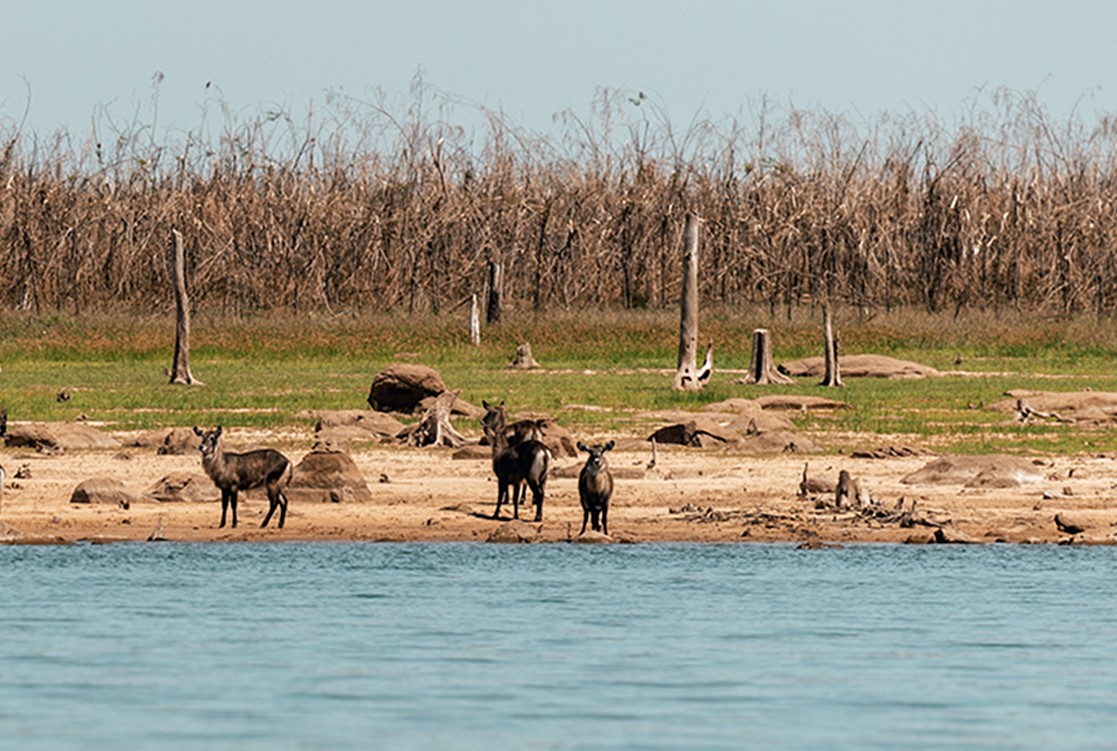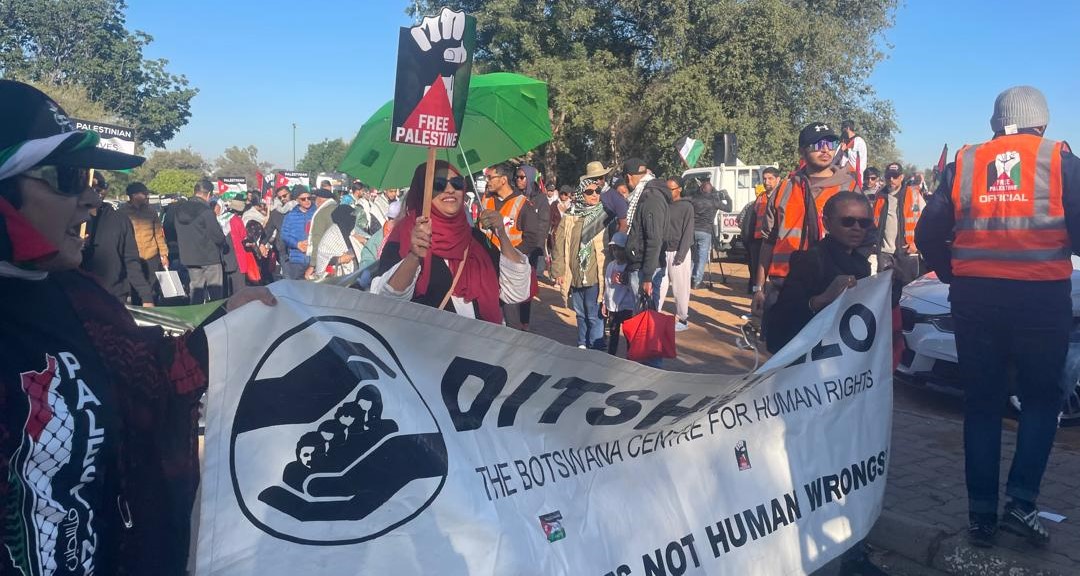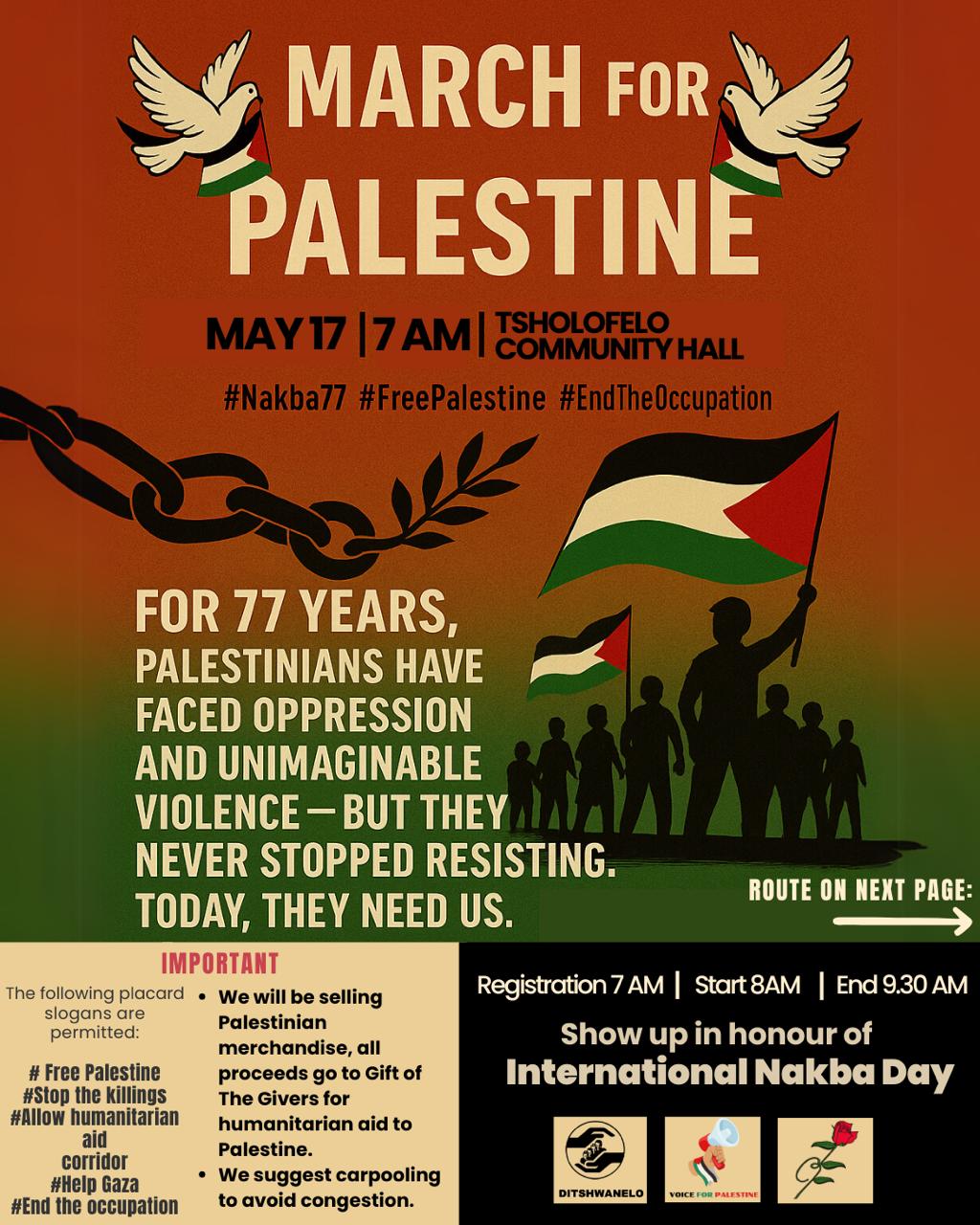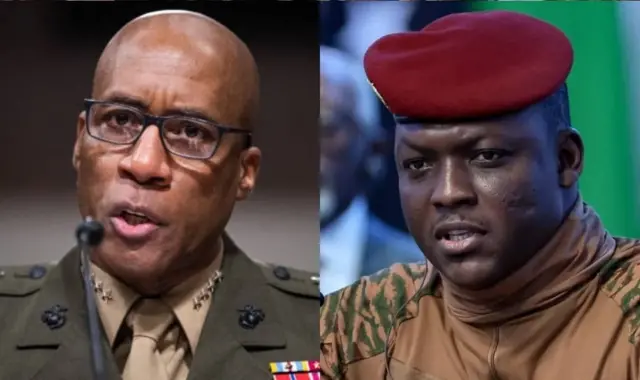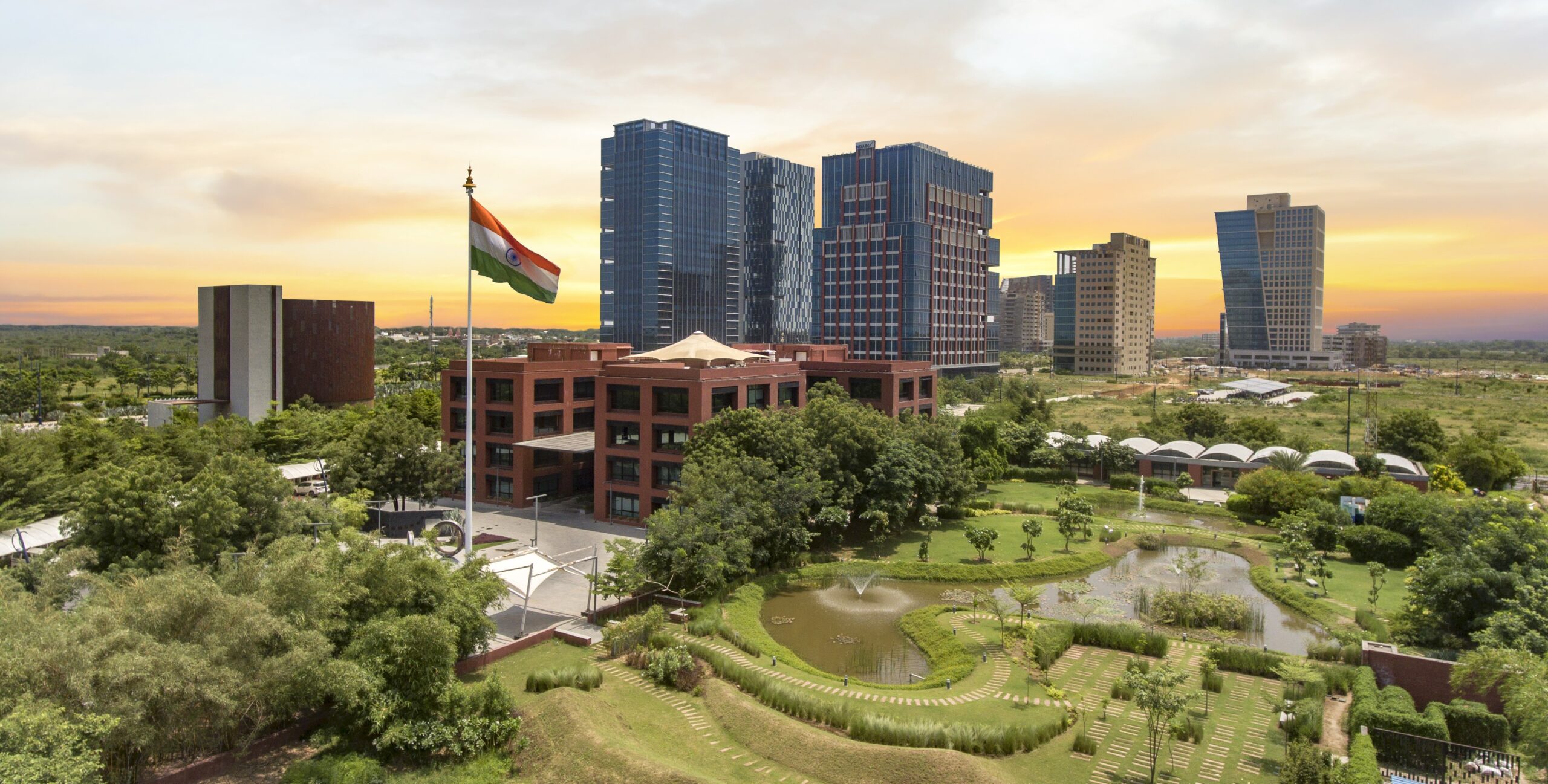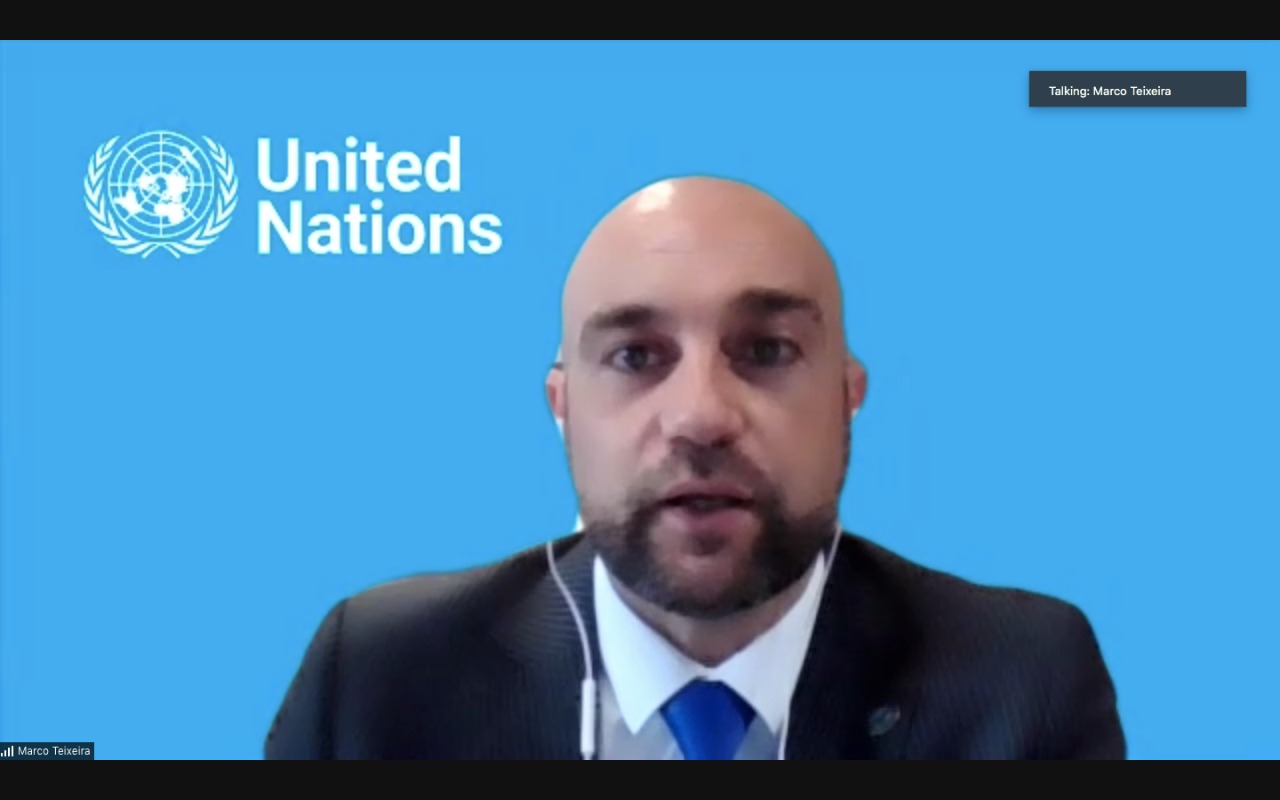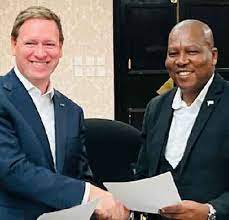
Minerals MIniister Lefoko Moagi shakes hands with De Beers Chief Executive Officer after signing the new diamond sales agreement
The Government of the Republic of Botswana and De Beers Group Announce a New Partnership For A New Era *Agreement in principle for new Debswana sales contract and mining licences
Joint Press Release
The Government of the Republic of Botswana and De Beers Group are pleased to announce they have reached an agreement in principle on a new 10-year Sales Agreement for Debswana’s rough diamond production through to 2033 and a 25-year extension of the Debswana mining licences through to 2054.
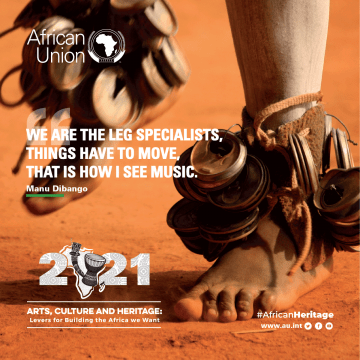
The transformational new agreement between the Botswana Government and De Beers reflects the aspirations of the people of Botswana, propels both Botswana and De Beers forward, and underpins the future of their Debswana joint venture through long term investment.
The agreement represents a new chapter in an enduring diamond partnership by focusing on four key areas of value: 1. Industry leadership: Significantly expanding Botswana’s footprint and leadership position across the diamond value chain, including a transition to increasing the share of Debswana supply sold via Okavango Diamond Company (ODC) to 50 per cent over the duration of the agreement.
From the start of the new contract period ODC will receive 30 per cent of Debswana production, progressively increasing to 50 per cent by the final year of the contract, ensuring a sustainable transition path for both partners.
2. Debswana’s future: Progressing the long-term capital investment required to secure Debswana’s position as one of the world’s leading diamond producers, and Botswana’s largest private employer, for decades to come.
3. Economic diversification: Accelerating Botswana’s economic diversification through the creation of a multi-billion Pula Diamonds for Development Fund, with an upfront investment by De Beers of BWP 1 billion (c. $75 million) and further contributions over the next 10 years that could total up to BWP 10 billion (c. $750 million) – which will aim to create substantial additional value to the Botswana economy.
4. Botswana jobs: Creating the potential for tens of thousands of new jobs in Botswana, both within an expanded Botswana-based diamond industry and emerging sectors, with a focus on supporting the growth of a knowledge-based economy.
Al Cook, CEO, De Beers Group, said: “For De Beers it is a privilege to renew our half-century partnership with the people of Botswana. It is a partnership that is highly regarded around the world for the enduring role it has played in creating economic development and growth.
“Our transformative agreement reflects the aspirations of the country, secures the future of our Debswana joint venture, and reaffirms De Beers’ leadership position for the long-term.
“The agreement represents our commitment to deliver investments in Botswana’s diamond production, Botswana’s diamond value chain, Botswana’s knowledge-based economy and, above all, the people of Botswana.”
While the partners progress and implement the formal Sales and Mining Agreements, the terms of the most recent Sales Agreement (which expired on 30 June) will remain in place. – Ends – Contact Press office Tel +44 (0) 20 7430 3434
About De Beers Group Established in 1888, De Beers Group is the world’s leading diamond company with expertise in the exploration, mining and marketing of diamonds. Together with its joint venture partners, De Beers Group employs more than 20,000 people across the diamond pipeline and is the world’s largest diamond producer by value, with mining operations in Botswana, Canada, Namibia and South Africa.
Innovation sits at the heart of the De Beers Group strategy as it develops its portfolio of brands, including De Beers Jewellers and Forevermark, and other pioneering solutions, such as recently launched diamond sourcing and traceability initiatives GemFair and Tracr.
De Beers Group employees are committed to ‘Building Forever,’ a holistic and integrated approach for creating a better future – one that is fairer, safer, cleaner and healthier; where safety, human rights and ethical integrity continue to be paramount; and where communities thrive and the environment is protected. De Beers Group is a member of the Anglo American plc group.
For further information, visit www.debeersgroup.com.
De Beers – Botswana deal signals rocky road for rough diamonds
By Felix Njini and Clara Denina July 3, 2023
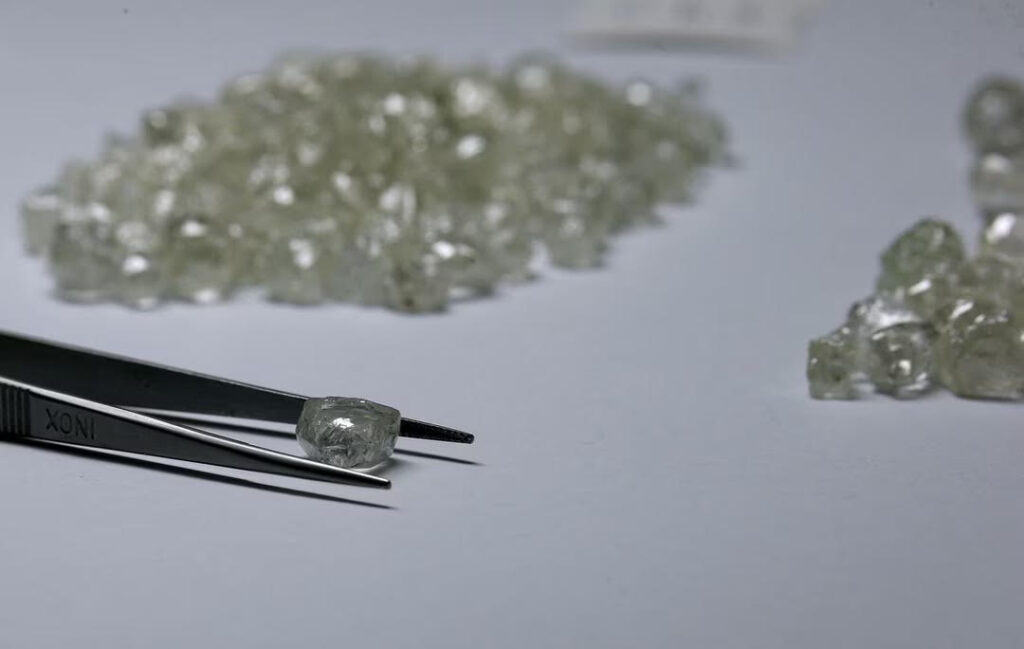
(Caption) Diamonds are displayed during a visit to the De Beers Global Sightholder Sales (GSS) in the capital Gaborone in Botswana November 24, 2015. REUTERS/Siphiwe Sibeko/File Photo
NAIROBI/LONDON, July 3 (Reuters) – An eleventh-hour deal between Botswana and De Beers over the weekend demonstrates the pressure the 135-year-old gems producer is under as it resets ties with its leading supplier amid pressure from falling prices and growing competition.
Both parties potentially had a lot to lose if talks broke down. While Botswana supplies 70% of De Beers’ rough diamonds, diamond sales account for two-thirds of Botswana’s foreign currency receipts, and a fifth of its gross domestic product.
Nonetheless, as the deadline for a new sales deal closed in, President Mokgweetsi Masisi publicly threatened to torpedo Botswana’s 54-year ties with De Beers unless it ceded a bigger share of rough stones to the state.
It sounded like populist rhetoric in a high-stakes negotiation – until the global diamond miner caved in.
“There was… a desire to cooperate and reach a deal. The opposite would have been very damaging for everyone concerned, for our industry,” De Beers CEO Al Cook, who took the helm of the company in February, told Reuters on Monday.
The company, along with the rest of the global diamond sector, is facing headwinds from a 6.5% drop in diamond prices in the year to date, and a loss of market share to synthetic diamonds.
Western customers seeking assurances that purchases do not come from Russia, where the other main producer Alrosa (ALRS.MM) is headquartered, also worked strongly in Botswana’s favour in the talks.
That helped the country wring handsome concessions from De Beers, including an increase in its share of diamond production from their Debswana joint venture to 30% in the near term and 50% by 2033, from 25% currently.
Botswana had already increased its share of gems from Debswana – sales of which stood at $4.588 billion in 2022 compared with $3.466 billion in 2021 – from 10% in 2011 to 25% in 2020.
In addition, the world’s number one producing country by value secured multi-billion dollar spending commitments to extend the life of its giant Jwaneng diamond mine, one of the world’s richest.
Analysts said the agreement weakens the investment case for the Anglo American (AAL.L)-owned gems miner.
“With the mines going deeper and capital operating costs significantly increasing, the investment required by De Beers for only 19.2% of the profits makes this partnership no longer the dripping roast it once was,” Richard Chetwode, a diamonds industry analyst said.
“Without diamond price upside, this deal makes the investment much more marginal,” he said.
Analysts at RMB Morgan Stanley said the pact could result in a $100 million hit on DeBeers’ core earnings. Over a decade, the impact on its finances may reach $200 million, or 15% of total earnings before interest, tax, depreciation and amortisation, they said.
“The agreement removes prospects of a protracted dispute and an eventual bear-case scenario that could undermine the economics of De Beers’ Botswana business altogether,” RMB Morgan said.
“Nonetheless, the outcome of these discussions is likely to result in additional value leakage.”
Cook, who said some analysts had misinterpreted the details of the deal, defended it.
“We had to do two things,” he said. “Make sure we got what we needed – and make sure that we got Botswana what it needed.” The deal achieved both, he said.
Reporting by Felix Njini and Clara Denina; Editing by Veronica Brown and Jan Harvey
Opinion: Project We Want More Offers More Questions Than Answers
by Sheila Khama
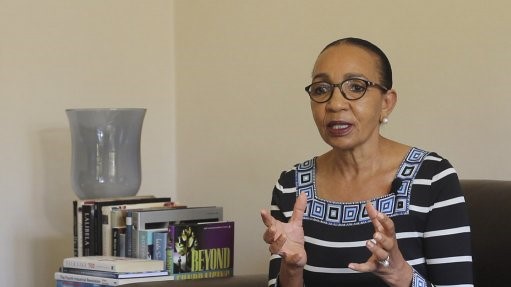
4th July 2023
In this opinion article, policy adviser and former CEO of De Beers Botswana Sheila Khama writes about the implications of the heads of agreement signed by the Botswana government and diamond miner De Beers for the renewal of the sale of Debswana’s diamonds and the renewal of certain mining licences.
On June 30, Botswana and De Beers jointly issued a heads of agreement announcing the conclusion of negotiations for the renewal of the sale of Debswana diamonds and the renewal of the mining licences for deposits on the books of the 50:50 Debswana joint venture owned by the two parties.
The joint press statement reported two main negotiation outcomes and, though the details were very sketchy, the announcement stated that an in-principle agreement had been reached to extend the sales agreement for Debswana’s rough diamond production by a further ten years until 2033.
In addition, and consistent with Botswana’s mining law, principle agreement had also been reached to extend the Debswana mining licences for 25 years. This is the maximum allowable by law and means that the licences are valid up to 2054. Each party hailed the agreements as transformational.
By July 1, additional details were provided. At a press conference, Botswana officials confirmed that, among others, the supply of diamonds from the Debswana Mines to the State-owned company Okavango Diamond Company (ODC) would increase immediately from 25% to 30% of the Debswana run-of-mine which is expressed in dollar value of carats produced.
Further to that the ODC share of production would be increased incrementally such that by the end of the ten-year validity period of the sales agreement the supply would reach 50%. Further to that a Diamond Development Fund & Skills Transfer, as well as a Botswana diamonds provenance initiative, were part of the high-level agreements, the details of which were still being thrashed out. On the other hand, Botswana and De Beers have included a ‘non-compete clause’ presumably to avoid a price war between ODC and De Beers Group sightholders sales.
SALES AGREEMENT OR PRODUCTION SHARING AGREEMENT?
In a press statement by the company, De Beers Group added even more colour to the way forward as relates to the sales agreement stating that increasing the share of supply to ODC would be “ensuring a sustainable transition path for both partners”. The Government of the Republic of Botswana and De Beers Group announce a new partnership for a new era – De Beers Group.
The statement raises the question of what the parties are transitioning towards. In the absence of details, it appears to be towards moving away from the 1969 single channel marketing and sales arrangement towards a Production Sharing Agreement (PSA) instead. What the announcements interestingly did not refer to was the impact of the changes on the profit sharing which was left at an 81:19 ration to Government.
Between future investments in mine development and reduction in share of production and therefore a fall in sales commission to De Beers, it is hard to see how the profit split can remain at this level without disidentifying De Beers in the long run.
For a number of reasons, the extension of the mining licence to Debswana was to be expected. Firstly, failure to extend it would disrupt operations especially as relates to mine development and continuity of future production. It would also have implications for the very future of the Debswana partnership. Finally, Botswana law gives De Beers right of first refusal over the mining of deposits as the company made the discoveries.
Therefore, the announcements suggest that though Botswana and De Beers are going separate ways when it comes to the sale of the Debswana production, they remain partners in mining, sorting and valuing.
In addition to any impacts on the profit split, what is missing in the announcement is an explanation why the increase in ODC’s supply is incremental and not immediate. There are several plausible explanations, the most likely one being availability of free cash flow from Debswana to both shareholders, to each be able to contribute to financing of the Jwaneng underground mine development, which will have to happen before 2033. It may also be intended to enable De Beers to synchronize the reduced supply with its three yearly sightholders contracts, some of which affect clients with factories in Botswana and due for renewal end of 2023.
On the other hand, given that ODC would double its volumes, it would presumably need to carry out some measures to ensure operational readiness. If so, this might suggest Botswana put the horse before the cart.
TRANSFORMATIONAL?
In the new dispensation, the 50% equity in Debswana appears to have been interpreted to mean not only equal entitlement to dividends, but equal share of run-of-mine production. Seen this way, the sales arrangements are indeed transformational, and Botswana enters the big league of rough diamond marketing. However, this raises questions about Botswana’s potential future role in the promotion of rough diamonds.
For instance, will ODC contribute towards the marketing and advertising budget, or will the State entity continue to rely on De Beers to drive price and demand? More importantly, what will the Government do with its share to improve beneficiation given that currently ODC auctions its share anywhere in the world and not to Botswana factories?
Otherwise, how doe Botswana create the much-needed jobs? Equally, given that less revenue will be received through De Beers sightholder contracts which guarantee revenue every sales cycle, how will the Government ensure stability of national revenue given the less predictable auctions outcomes? Indeed, how will the government mitigate the risk of a fall in public revenue during poor market conditions which often leads to low auction turnout?
Hopefully Botswana’s leaders have plan B, the details of which will be made public in due course.
DE BEERS MARKET FOOTPRINT?
The elephant in the room is what the 30% leading to 50% share to ODC does to De Beers’ revenue and market footprint? The company’s current market share is estimated at 34% and will drop further. The question is how will the company adjust to the new environment? The company has limited options including scaling down to become a smaller but more profitable company as was envisioned in the 2006 Supplier of Choice strategy.
This might mean cutting down on investment in advertising, R&D in mining and sorting and valuing. On the other hand, subject to sanctions against Russia by the EU and US, one wonders whether an opportunity is legally available for De Beers to close the gap with a sales agreement with Alrosa or whether EU anti-trust laws rule this out. Importantly, given that the Sales Agreement with Debswana expires in 2033, the logical question is what will follow post 2033? Will Botswana turn the tables on De Beers and become the main agent for the sale of Debswana goods?
Undoubtedly, investment analysts in the city of London and Anglo shareholders will be pondering these questions and only time will tell how the issues are addressed but for now, the information gap is glaringly missing in its absence. Unless one assumes there is no tipping point.
SECURITY OF TENURE
According to the Annual Survey of Mining Companies, 2022 | Fraser Institute, Botswana was rated top in Africa and on par with others elsewhere including Western Australia for attractiveness as a destination for mineral exploration based on regulatory effectiveness. Botswana’s legendary regulatory consistency has manifest once again proving that on application of the law and therefore guarantee of investor security of tenure, Botswana is indeed a worthy mining destination. The mining licences for the four lease areas only expire in 2029.
Pragmatically and to pave the way for investment in the Jwaneng resource extension-related mine development projects by the shareholders of Debswana, the decision to renew the licence has been brought forward by six years. The subtlety cannot be lost on De Beers and other investors that Botswana remains open for business. This, operational efficiencies, and the highly profitable nature of the Jwaneng deposit must give comfort to Anglo despite the reduction in share of production.
ECONOMIC DIVERSIFICATION
In its press statement, De Beers stated that as part of the arrangements the parties plan on ‘accelerating Botswana’s economic diversification through the creation of a multibillion-pula Diamonds for Development Fund, with an upfront investment by De Beers of one-billion pula (about $75-million) and further contributions over the next ten years that could total up to ten-billion pula.
The statement is not explicit but the lack of mention of any contribution by the State must be interpreted to mean there is no contribution by the government. This significant financial commitment is in a country in which the 2022 overall development budget of 16.43-billion pula for 2022/23 was a 11.4% year-on-year increase from a 2021/22 budget.
What is not clear is how the fund will be managed. Also, the statement begs the question of how a private company steeped in diamonds succeeds in diversifying Botswana’s economy where one administration after another has struggled to diversify Botswana’s economy for five decades. It will be interesting to understand the scope and project management and governance framework.
A FIFTY-YEAR-OLD TEMPLATE?
If the reader follows the history of deals between Botswana and De Beers, a pattern might emerge. Though deliverables from each sales agreement vary, they nevertheless follow a pattern. In a nutshell, each renewal of both the mining licences and sales agreements since 1969 has been associated with an add-on which one might call ‘cost of doing business’ for De Beers that are similar to the Pula Diamonds for Development Fund.
For instance, in 1969, De Beers funded civil infrastructure and hospital construction, operational costs that to this day serve as referrals for patients from government primary healthcare clinics.
For the 1978 first Jwaneng mine licence, in addition to a profit split of GRB = 75% De Beers = 25% De Beers paid for the design and construction of the Orapa House diamond sorting facility and leased to Debswana for P1.00 per year till 2008. For the renewal of the same lease in 2004, and in addition to a profit split of GRB = 80,8% De Beers = 19,2%, De Beers financed and equipped the US$82 sorting and valuing facility to house a new JV DTC Botswana. The latest agreements follow a very similar pattern.
NONE BUT OURSELVES
Fifty years is a long time, and Botswana and De Beers have done well. Any suggestion to the contrary flies in the face of reason. The country owes much to its leaders. Sir Seretse Khama gave it nationhood through collective ownership of minerals. Sir Ketumile Masire gave the country revenue through 50% equity in Debswana. Festus Mogae set the foundation for the 38 cutting and polishing factories, acquired 15% in DBSA, established the DTCB JV and was the architect for De Beers’ relocation to Botswana. Lt. General Ian Seretse Khama gave the country ODC. Now President Masisi, has delivered 50% of Debswana production to the same State-owned entity.
As can be seen, the milestones and figures are impressive and make for a good victory lap. But one must ask what of the long term? The only way to answer this question is by tracking the impacts of these deals on the economy, on the stated desired outcomes and as such the people of Botswana and her people. In the absence of the Government of Botswana having articulated the end-state vision with respect to the agreed terms from June 30, 2023, it is not clear what citizens should expect and when. Importantly, one is left wondering whether the development of a country’s most valuable mineral asset is guided by periodic negotiations with a private company and not a vision?
© Mining Weekly
Botswana and De Beers Sign Deal to Continue Rich Diamond Partnership
Under the new joint mining agreement, Botswana will immediately get a 30 percent share of the rough stones extracted, up from 25 percent, and it will rise to 50 percent within a decade, De Beers and government officials said.
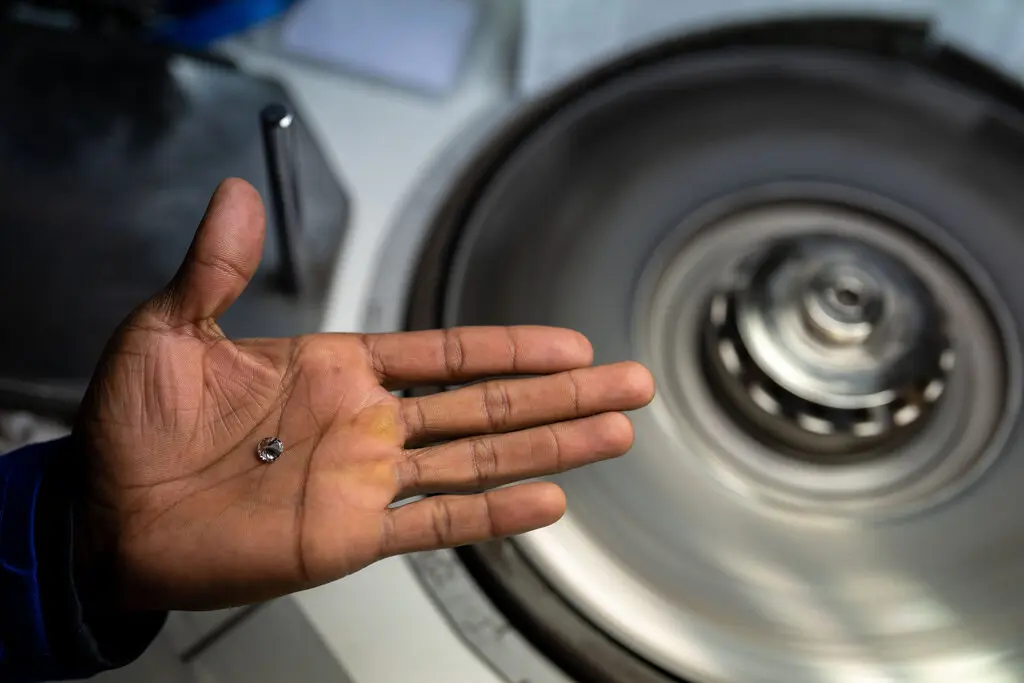
(Caption)
A diamond that was processed at the Aurostar plant in Gaborone, Botswana. Credit…Joao Silva/The New York Times
By John Eligon
Reporting from Johannesburg
July 1, 2023
A Botswana government official and the chief executive of De Beers, the international diamond conglomerate, signed interim agreements on Saturday to continue a lucrative, decades-long diamond mining partnership that had appeared to be breaking down in recent months.
Only minutes before a midnight deadline on Friday, the parties announced that after years of negotiations, they had agreed in principle on a deal to renew a partnership that supplies De Beers with most of its diamonds and Botswana’s government with the largest chunk of its revenue.
The details of the deal were still being worked out, officials with the government and De Beers said. But it addresses one of the most significant gripes of the Botswana government, regarding the share of diamonds it receives in its joint mining venture with De Beers. Under the old agreement, Botswana received 25 percent of the rough stones extracted, while De Beers took the rest. Now, Botswana will immediately get a 30 percent share, and that will rise to 50 percent within a decade, De Beers and government officials said.
De Beers said in a statement that it had agreed to invest as much as $825 million over the next 10 years to help develop the Botswana economy. The agreement also includes establishing an academy in Botswana that will train locals in skills in the diamond trade, government officials said.
The government of Botswana, the world’s second largest diamond producer, hailed the agreements as a sweeping victory for the country of 2.4 million people, saying they would allow the southern African nation to achieve its long-term development goals.
“I must say with excitement that these are transformational agreements,” Lefoko Fox Moagi, the minister of minerals and energy, said on Saturday as he sat next to De Beers’s chief executive, Al Cook, to sign the deals. “These are talking to the aspirations of the people of Botswana.”
This year, Botswana’s president, Mokgweetsi Masisi, caused a stir when he made the unusual move of publicly criticizing the deal with De Beers, saying that his country was essentially being cheated.
“We must refuse to be enslaved,” he said in May at a community meeting in a rural village.
Mr. Masisi and other government officials demanded that Botswana receive more than 25 percent of the rough stones, and that De Beers make some investment in helping to expand other areas of the diamond industry in Botswana, including cutting and polishing, jewelry making and retail sales.
In challenging De Beers to give them more, Botswana officials were pressing a broader demand of African countries to get more from the natural resources that belong to them. There is a long history of countries on the continent losing out on their resource wealth to theft, corruption and mismanagement.
Mr. Cook said that Botswana government officials had been clear on the need for De Beers to invest beyond diamonds and in the knowledge-based economy, and to develop the diamond value chain and put the people of the country first.
“I believe that the deal that we have agreed does all of that,” Mr. Cook said during the signing ceremony.
The government said that the sales agreement, which deals with how the diamonds are allocated, had been extended to 2033. Separately, De Beers’s mining license was extended to 2054, giving the company some assurance that it would have a long-term future in the country.
Despite the government’s demands for a fairer deal, few would dispute that diamonds have already transformed Botswana in ways that many African nations can only envy.
In 1966, the year that De Beers first discovered diamonds in Botswana and that the country gained independence from Britain, Botswana was among the poorest countries in the world, with only about seven and a half miles of paved roads. Now, it is considered an upper-middle-income country, with robust infrastructure and the sixth highest economic output per person in Africa, according to the World Bank. The partnership with De Beers produced about $2.8 billion in revenue for Botswana last year.
But the World Bank also ranks Botswana as one of the most unequal countries on the planet, and Botswana citizens and government officials have said that they deserve to earn more from the diamonds that are buried in their soil in order to address the lingering social ills.
Yvonne Mooka contributed reporting from Mahalapye, Botswana.John Eligon is the Johannesburg bureau chief, covering southern Africa. He previously worked as a reporter on the National, Sports and Metro desks. His work has taken him from the streets of Minneapolis following George Floyd’s death to South Africa for Nelson Mandela’s funeral. @jeligon
(C) New York Times
